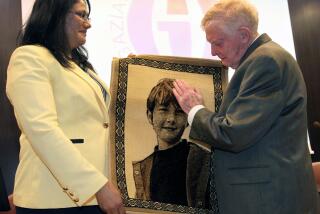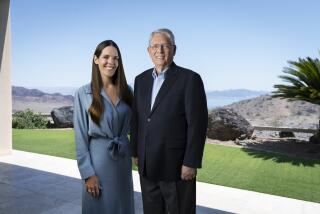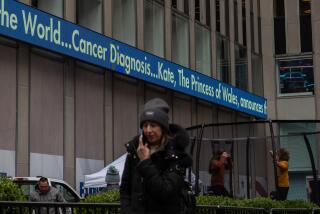Families Bound by Hope
- Share via
DURHAM, N.C. — John and Alicia Bennett will become members of an unofficial club today that parents join only in desperation.
They have a child with a rare genetic condition called Sanfilippo syndrome, which causes progressive organ damage and death. And, like only five other families before them, the Bennetts are investing all hope for saving his life in an experimental stem-cell transplant here at Duke University Medical Center.
From different corners of the nation, these families have found each other and formed tight bonds. They’ve read each other’s Internet diaries, compared their children’s progress, prayed for a full recovery and even bought each other strollers and blankets.
As doctors try to stretch medicine’s frontier to find a cure, the families in this group can understand each other’s misery and joy like no one else.
“It feels like we’re all [one] family now,” said Alicia Bennett of Ione, Calif., as she braced herself for 3-year-old Tommy’s transplant. “It’s not ‘Oh that kid.’ ... He’s one of ours.”
The Bennetts have more than their share of worries. Their two older children, Ciara, 6, and Hunter, 4, also have Sanfilippo, and are too disabled to undergo the transplant. If the disease takes its usual course, they almost certainly will die by their early teens.
Yet the photo montage on Tommy’s hospital door includes pictures of other children: Andrew Bowman, the second Sanfilippo child to receive a stem-cell transplant, and Jillian Fitzpatrick, who received her transplant Thursday, a day before Tommy’s.
This network didn’t exist when Bernadette Gray’s 6-year-old daughter, Julia, underwent her stem-cell transplant in February 2001. Julia was the first Sanfilippo child in the nation to receive the experimental procedure, researchers say.
“It would have been nice to know of somebody else who had been through it,” said Julia’s mother, who lives in Atlanta. “It was just the fear of the unknown.”
Sanfilippo children lack an enzyme needed to break down chains of sugar molecules. Over time, these molecules build up, which causes the severe organ damage.
Sanfilippo and other rare diseases often leave victims and their families feeling “very isolated because they don’t know anybody else with the disease. They’ve never met anybody else with it,” said Abbey Meyers, president of the National Organization for Rare Disorders, which keeps a database of 1,100 rare diseases on its Web site.
“You can go to your corner church and go to a support group meeting for arthritis or cancer, but you can’t with rare diseases.”
Instead, these people increasingly are using the Internet and other means to seek each other out.
Networking has some drawbacks, some families and doctors say. Parents tend to compare their children’s progress, and when one child suffers a setback, other families become paranoid that their children will too.
“In some respects, ignorance was bliss,” Gray said of being first. “We weren’t as concerned because we didn’t know any better.”
But the Bennetts and other families say they want to know the course of disease in other children and the effects of the transplant so they are not surprised.
“I hate to say it, but I’m kind of a control freak,” said Fitzpatrick, Jillian’s mother. “It helps me to know.”
Fitzpatrick said she’s glad that her daughter and Tommy are only one day apart in the transplant process. She and Tommy’s mother compare notes every day. Jillian, for instance, broke out in hives on Tuesday from a chemotherapy drug; Tommy’s hives came on Wednesday night.
“It’s almost like a clique,” said Fitzpatrick, who lives in the suburbs of Cleveland. “You just instantly feel a connection to them.”
Fitzpatrick keeps an online diary, detailing Jillian’s daily treatment regimen and voicing fears and hopes. So do the Bennetts and all of the other Sanfilippo families that have gone through the transplant process.
Ellen Bowman, Andrew’s mom, said she talks regularly to the other families by phone. On her Web site, she keeps a list of children who could use prayers from others.
“I want Andrew to do well not just for Andrew,” his mother said. “I want Andrew to do well for all the other children and parents who look at Andrew and say, ‘He will be the first one to tell us whether it is successful or not.’ ”
Angie Cottey, whose son Kyle had two transplants -- one was unsuccessful -- said she relies on Bowman to help her through the process. “When I’m upset and I feel I can’t take it any more, I call her.”
Today, Tommy will receive a blood transfusion rich with stem cells derived from umbilical cord blood, which doctors hope will replace his deficient cells and produce the enzyme his body is lacking.
Researchers say it’s too soon to say whether the transplants will work, as they have for young patients with related diseases.
Even if the transplants are successful, the doctors caution that the children will never be normal or close to it. And there’s a chance of death and complications during the transplant process.
Dr. Joanne Kurtzberg, director of Duke’s pediatric bone-marrow transplant program, would like to perform the transplant on 15 to 20 Sanfilippo children to fully study its effects.
“If we saw something negative, that would make me reevaluate whether we should be doing it,” she said.
*
Previous stories about the Bennetts can be found at www.latimes.com/bennett.






